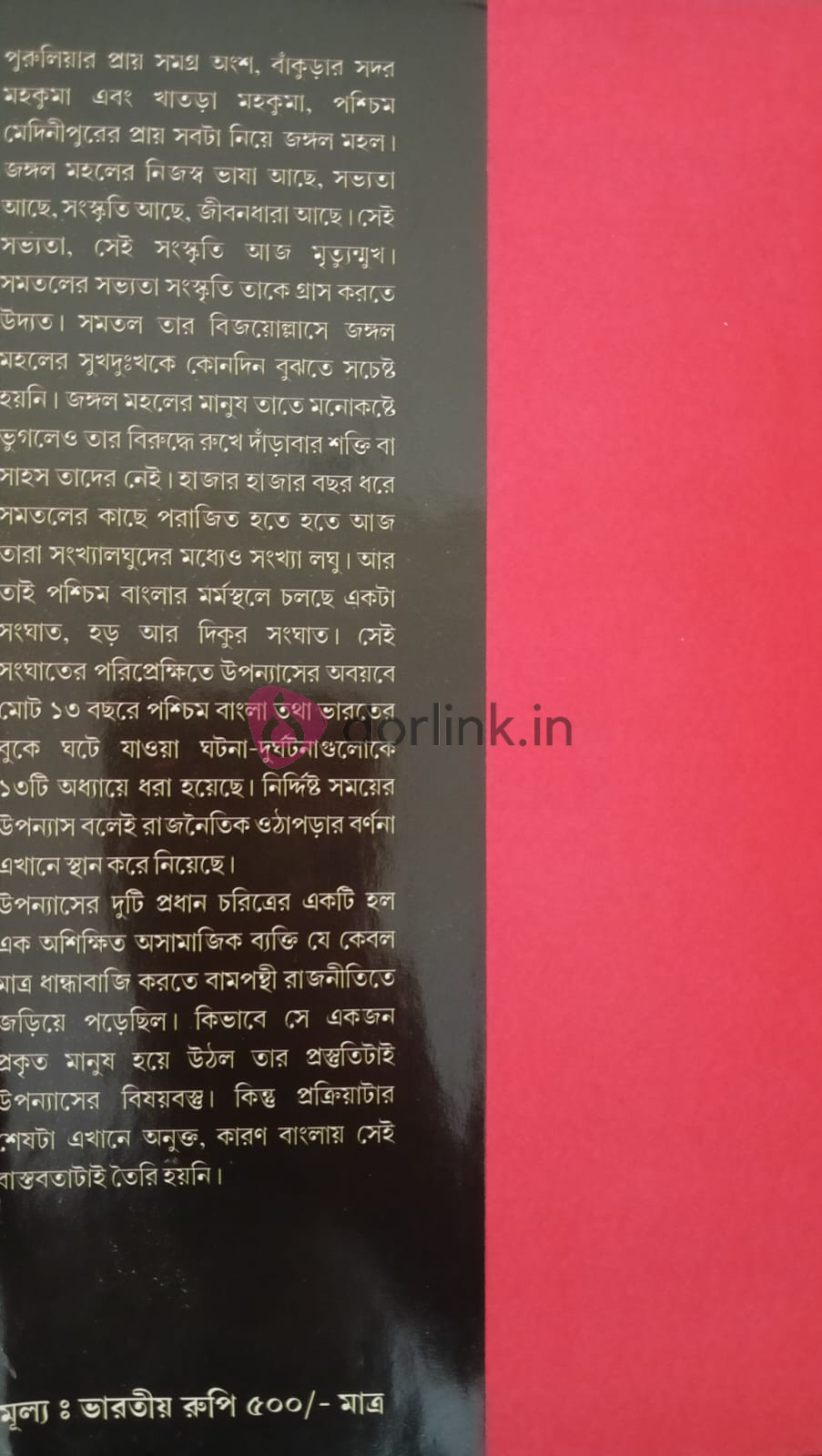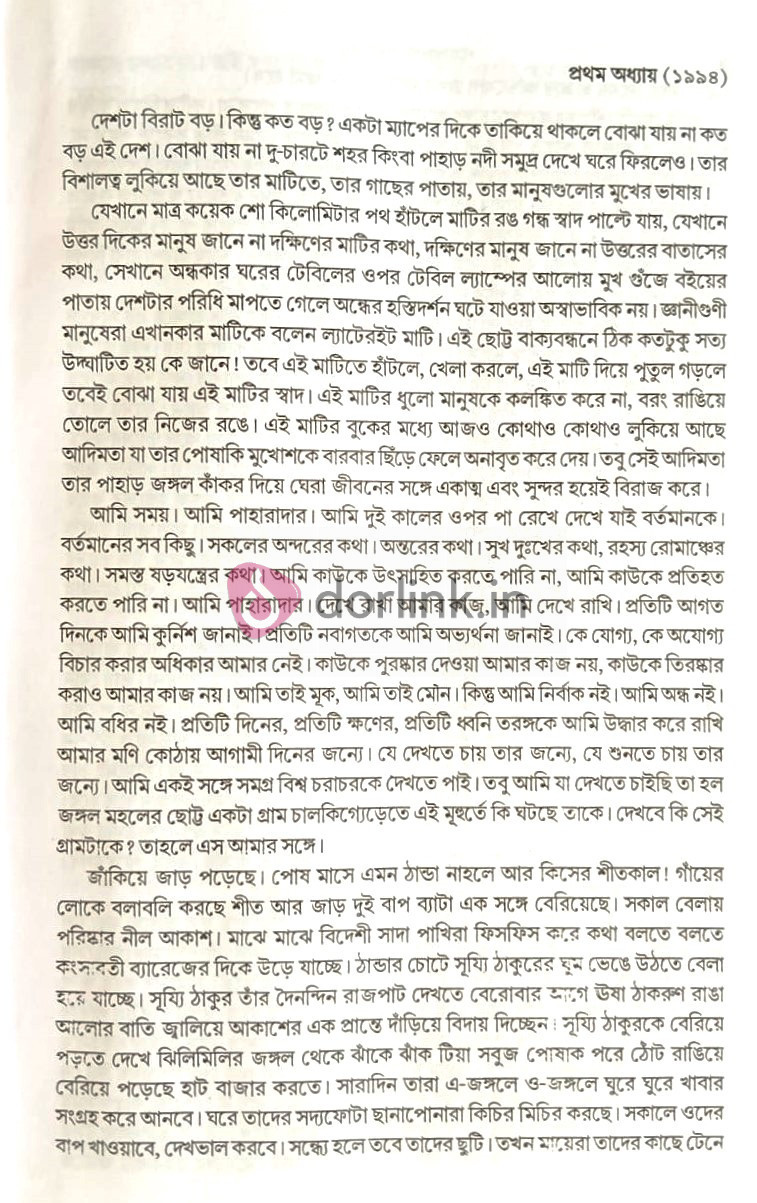Writer : Pranab Bhattacharjee
- Shipping Time : 7 Days
- Policy : Return/Cancellation?
You can return physically damaged products or wrong items delivered within 24 hours with photo/video proof.
Contact Customer Support for return initiation and receive return authorization via email. Securely package for return.
Refunds for eligible returns are processed within 7-10 business days via Bank Transfer.
Order cancellation allowed within 24 hours of placing it. Standard policy not applicable for undamaged/wrong product cases. Detailed info. - Genre : Literature>Novels & Novellas
- Publication Year : 2017
- ISBN No : NA
- Binding : Card Board (Hard) with Gel Jacket
- Pages : 592
- Weight : 800 gms
- Height x Width x Depth : 8.5x5.5x2.3 Inch
If so, it will be notified
About the Book
নিঃশব্দে জ্বলতে থাকা এক ভূখণ্ড — জঙ্গল মহলকে কেন্দ্র করে সমকালীন রাজনৈতিক প্রেক্ষাপটে লেখা বাংলার সামাজিক উপন্যাস যা সেরা সমালোচকের দৃষ্টিতে “এযুগের মহাভারত”
এই উপন্যাসের কাহিনি পশ্চিমবঙ্গের হৃদয়ে এক গভীর, বিস্মৃত সংঘাতকে কেন্দ্র করে – জঙ্গল মহলের। পুরুলিয়ার প্রায় সমগ্র অঞ্চল, বাঁকুড়ার সদর ও খাতড়া মহকুমা এবং পশ্চিম মেদিনীপুরের বিস্তীর্ণ এলাকা জুড়ে যে প্রাকৃতিক, সাংস্কৃতিক ও জনজাতিগত পরিসর – তাকে আমরা চিনি ‘জঙ্গল মহল’ নামে। এ শুধু ভৌগোলিক পরিসর নয়, এক অনন্য সভ্যতা, ভাষা, সংস্কৃতি ও জীবনধারার প্রতিনিধিত্বকারী অঞ্চল। কিন্তু এই সভ্যতা আজ চরম সংকটে – সমতলের আধিপত্যবাদী সংস্কৃতি, তার অন্ধ আধুনিকতা ও রাজনৈতিক বিজয়োল্লাস জঙ্গল মহলের অস্তিত্বকে ধীরে ধীরে গিলে ফেলছে।
জঙ্গল মহল বনাম সমতল – এই দুই বিপরীত জগতের সংঘাতই এই উপন্যাসের কেন্দ্রে। হড় এবং দিকু–এই দুই প্রতীকী চরিত্রের দ্বন্দ্বে গড়ে উঠেছে এক সামাজিক ও রাজনৈতিক ভাষ্য। হড়– যে প্রান্তিক, পরাজিত, নিস্তব্ধ। দিকু– যে আধিপত্যশীল, বিজয়ী, অথচ আত্মসন্তুষ্ট। এই উপন্যাস তাই শুধু কোনও ব্যক্তিগত যাত্রার বিবরণ নয়, বরং এক গোষ্ঠীর অস্তিত্বসংগ্রাম, এক সভ্যতার করুণ প্রয়াণগাথা।
পুরো কাহিনি বিন্যস্ত হয়েছে ১৩ বছরের ১৩টি অধ্যায়ে, যেখানে পশ্চিমবঙ্গ তথা ভারতের সাম্প্রতিক ইতিহাসের উপর দিয়ে বয়ে যাওয়া তীব্র রাজনৈতিক, সামাজিক ও সাংস্কৃতিক ধাক্কাগুলিকে ধরার চেষ্টা করা হয়েছে। এই ১৩ বছরের বিস্তৃত সময়কালকে উপন্যাসের কাঠামোয় নিয়ে এসে ঘটনাগুলোকে রূপান্তরিত করা হয়েছে সাহিত্যের ভাষায়। ফলে এটি একটি নির্দিষ্ট সময়কালের রাজনৈতিক উপন্যাস, যা ইতিহাস ও কল্পনার সংযোগস্থলে দাঁড়িয়ে।
উপন্যাসের কেন্দ্রীয় দুই চরিত্রের মধ্যে একটির পরিচয় আলাদা করে উল্লেখযোগ্য। সে এক অশিক্ষিত, সমাজবিচ্ছিন্ন দুষ্কৃতী, যে প্রথমদিকে কেবল স্বার্থসিদ্ধির উদ্দেশ্যে বামপন্থী রাজনীতির সঙ্গে যুক্ত হয়েছিল। কিন্তু সময়, পরিবেশ, অভিজ্ঞতা ও সংঘাত তাকে পূর্ণতা দেয়। এক অসামাজিক মানুষ থেকে ধীরে ধীরে একজন ‘কমিউনিস্ট’ হয়ে ওঠার যাত্রাপথই এই উপন্যাসের আসল উপজীব্য। তবে তার এই রূপান্তরের প্রক্রিয়া এখানেই শেষ নয় – কারণ বাংলায় এখনও সেই পরিপূর্ণ বাস্তবতাটির অভাব রয়েছে, যা নিকোলাই অস্ত্রভস্কি তাঁর জীবনে পেয়েছিলেন।
কেন পড়বেন এই উপন্যাসটি?
- জঙ্গলমহলের প্রান্তিক জনগোষ্ঠীর বাস্তবতা ও সংগ্রামকে গভীরভাবে অনুধাবন করতে।
- বাংলার সাম্প্রতিক রাজনৈতিক ইতিহাসের প্রেক্ষাপটে একটি মানবিক কাহিনি উপভোগ করতে।
- একজন মানুষের আত্মপরিবর্তনের যাত্রা ও সমাজের আদর্শচ্যুতির চিত্র দেখতে।
- সাহিত্যিক দৃষ্টিকোণ থেকে সামাজিক ও রাজনৈতিক পরিবর্তনের বিশ্লেষণ করতে।
এই উপন্যাস একান্তই রাজনৈতিক নয়, আবার নিছক মানবিকও নয়। পুরুলিয়া, বাঁকুড়া, এবং পশ্চিম মেদিনীপুরের বিস্তীর্ণ অঞ্চল নিয়ে গঠিত জঙ্গলমহল, যেখানে আদিবাসী জনগোষ্ঠীর নিজস্ব ভাষা, সংস্কৃতি ও জীবনধারা রয়েছে। সমতলের আধিপত্যবাদী সংস্কৃতি ও রাজনীতির চাপে এই অঞ্চলটির স্বতন্ত্রতা হুমকির মুখে। উপন্যাসটি এই সাংস্কৃতিক সংঘাত ও অস্তিত্বের লড়াইকে গভীরভাবে উপস্থাপন করেছে। এটি সেই সীমারেখা যেখানে রাজনীতি, সংস্কৃতি, অস্তিত্ব ও মনুষ্যত্ব একে অপরকে প্রশ্ন করে। জঙ্গল মহলের আত্মা ও আত্মসংঘাতকে ধারণ করে লেখা এই উপন্যাস বাংলা সাহিত্যে এক অনন্য প্রতিফলন।
[A Land, a Heart and some Lives Burning in Silence — A contemporary socio-political novel set against the political backdrop of Jungle Mahal, West Bengal, India, hailed by discerning critics of Bengali literature as “the Mahabharata of our times.”
At the heart of this novel lies a profound, often forgotten conflict — that of Jungle Mahal, the forested heartland of West Bengal. Stretching across almost the entire district of Purulia zilla, the Bankura zilla, and the vast swathes of Paschim Medinipur zilla, this expanse of land, culture, and indigenous identity is known collectively as Jungle Mahal. But it is far more than mere geography —it embodies a unique civilization, language, culture, and way of life. Today, however, this civilization stands at the precipice of extinction —slowly engulfed by the dominant culture of the plains, with its blind modernity and triumphalist politics.
At the novel’s core is the clash between two opposing worlds: Jungle Mahal and the Plain land. This conflict unfolds through two symbolic figures known as Hoḍ and Diku. Here, Hoḍ is the marginal, the defeated, the silent aboriginal people of Jungle Muhal in their language. And the Diku is the dominant, victorious, yet complacent people of the plain lands. Thus, the novel is not merely the chronicle of an individual's journey, but a collective struggle for existence —a lament for a vanishing civilization.
The narrative is woven across 13 chapters, spanning over 13 tumultuous years, within a time-frame of 1993 to 2006, just before the historical Singur land strife was started —years that bear the scars of West Bengal’s and India’s political, social, and cultural upheavals. By encapsulating this sweeping era within the framework of fiction, the novel transforms real events into a poignant literary experience. It elaborately depicts the decay of Communist Parties and the evolution of a Rightist party in West Bengal. The book is a deed of political intricacy in West Bengal, as well as, in India. It stands at the very intersection of history and imagination — a socio-political novel of a defined era, rich with layered meaning.
The storyline of the novel is depicted by “The Mahakal or The Time” as it observes the life of the people of a particular village of the Jungle Muhal and the other parts of the country where the footsteps of the characters stepped in.
Among the novel’s two central characters, one deserves special mention — The 1st lead character, a miscreant, Binod —an uneducated, socially alienated outlaw, was inducted by a leftist Ruling party for some antisocial work who accepted this as a scope to make money. But as the days went by, he failed to exact money from the poor villagers as they were his friends from a young age. On the other hand, he filtered himself after reading the ideological notes of the party, whereas the party itself dissolves because of not following those values. From an antisocial outcast, he slowly evolves into a Communist in the truest sense. However, his journey toward this transformation remains incomplete —for Bengal still lacks the full, lived reality that Nikolai Ostrovsky once captured in his own lifetime.
The 2nd lead character, the daughter of Binod, Shobhana rises from a family of country-liquor brewer to be the First among the girl students in the district, in JEE. She was admitted into the Jadavpur Engineering College and passed successfully to occupy a lucrative job in Bangalore.
Here, she met Mekhla, the 3rd leading character, upon whose hand the story revolves sometime. Shobhana’s marriage, arranged by her kins, was a mistake which ended up the court-case and divorce. She led a people unrest against a gang rape and murder in Bangalore, which brought her into an international platform. The 4th lead character, Rangama, the 5th aunt of Shobhana holds a key role in the novel. She possesses a beautiful personality that governs the family as well as the society and portrays the feminine force which led the Bengal intelligentsia from behind and kept the morals alive within the coming generation under the Bengali communities, increasingly missing in the era of post-modern society.
The Jungle Muhal has a set of Rules of Law for its own inhabitants – human and animal beings, promulgated far beyond the history it starts writing. Here the women enjoy a freewill for love and sex. It is followed by men uninterruptedly and without giving much attention to the Laws of the Land. The book portrays different types of love and its psychological dilemma. Shobhana fell in love, at her teenage, with her cousin which lasted for a long time. Her roommate-cum-friend in Bangalore, Mekhla loves her English tutor from her teenage. He is old and married but, in her eyes, he is the Prince of a fairy tale, he is the hero of her dreams. She loves him even after her marriage. Mekhla’s love of Shobhana is also questionable.
This epic novel ends with the escape of Binod from the village as he was continuously becoming an eyesore to his party for his development of knowledge and puritanism in communism. He flees home in search of a friend with the same ideological belief for the betterment of the society.
This novel is neither purely political, nor merely a humanitarian account. It captures Jungle Mahal —a region formed by Purulia, Bankura, and Paschim Medinipur —where indigenous communities nurture their own languages, cultures, and rhythms of life. Today, these distinct identities face grave threats under the crushing weight of mainstream politics and dominant cultural forces. The novel poignantly portrays this cultural conflict and existential struggle —the very fault line where politics, culture, existence, and humanity collide. Embodying the soul and silent battles of Jungle Mahal, this novel stands as a rare and resonant reflection in contemporary Bengali literature.]




